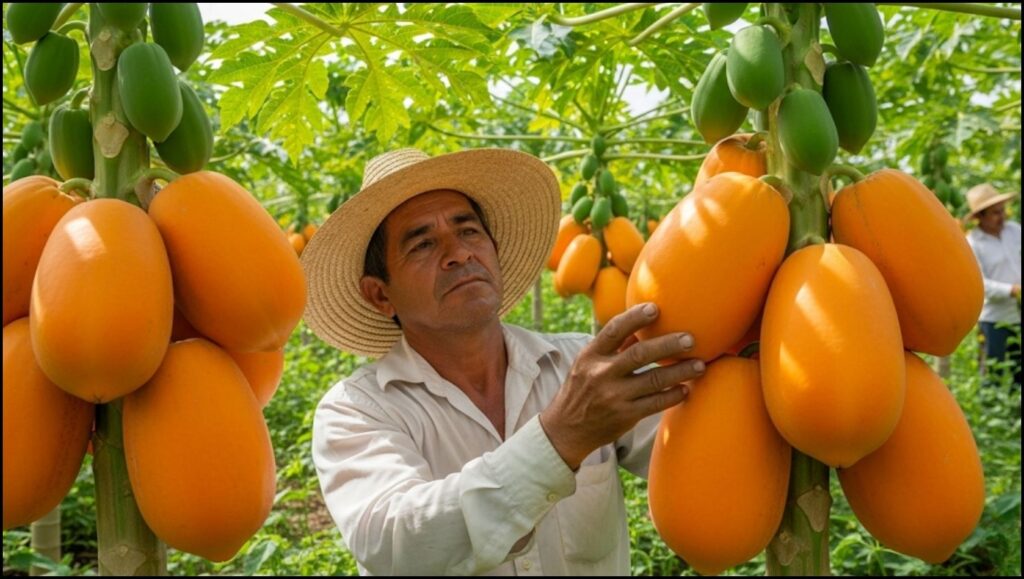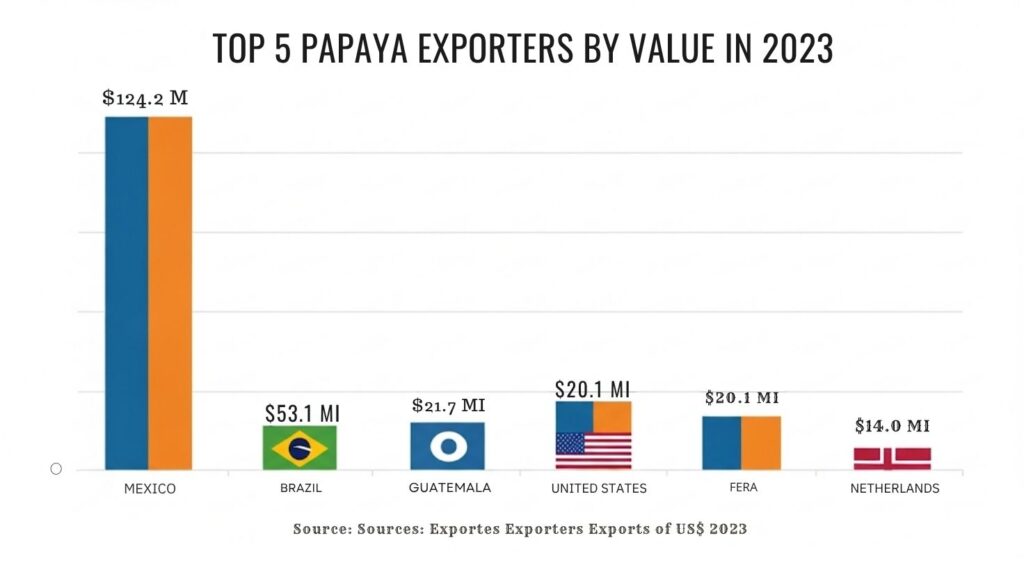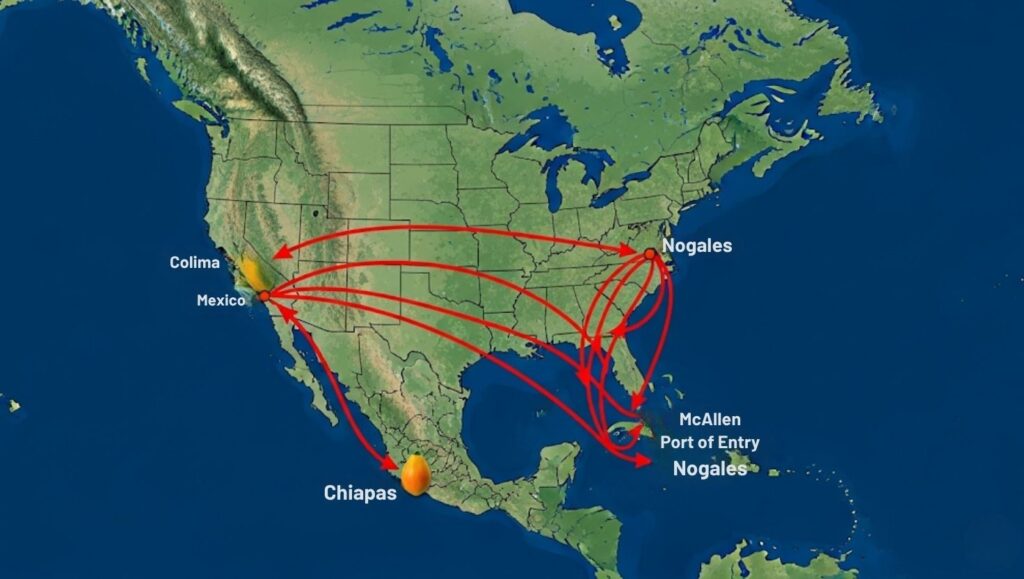Mexico has firmly established its dominance as the largest papaya exporter in the world, shipping hundreds of millions of dollars’ worth of the tropical fruit annually, primarily to the United States. This commanding position is bolstered by favorable growing conditions, strategic trade proximity, and cultivation of the highly sought-after Maradol variety, shaping the global papaya trade.

Largest Papaya Exporter in the World
| Key Fact | Detail / Statistic |
| Top Exporter | Mexico exported approximately $139 million worth of papayas in 2023. |
| Top Importer | The United States accounts for over 80% of Mexico’s papaya exports. |
| Top Producer vs. Exporter | India is the world’s largest producer of papayas but consumes most of its crop domestically. |
| Key Variety | The Maradol papaya variety constitutes the vast majority of Mexico’s exports. |
Mexico’s Recipe for Dominance in Papaya Exports
For decades, Mexico has leveraged its unique geographical and agricultural advantages to become the world’s premier papaya supplier. In 2023, the country’s papaya exports reached a value of approximately $139 million, dwarfing its closest competitors, according to data from the International Trade Centre. The overwhelming majority of this fruit, nearly 200,000 metric tons, finds its way to shelves in the United States.
This success is no accident. The nation’s key papaya-growing states, such as Colima, Michoacán, and Chiapas, possess the ideal tropical climate for year-round cultivation. This consistent production cycle ensures a steady supply for international markets, a critical factor for importers who rely on predictability.
“Mexico’s proximity to the U.S. is its single greatest logistical advantage,” said Dr. Isabella Reyes, an agricultural economist specializing in Latin American trade. “It allows for the rapid transport of fresh, perishable fruit by truck, which is far more cost-effective and faster than the sea freight required by competitors in South America or Asia. This preserves freshness and extends shelf life, which is paramount in the tropical fruit market.”
Furthermore, Mexican growers have perfected the cultivation of the Maradol papaya. This variety is known for its vibrant reddish-orange flesh, sweet flavor, and resilient skin that holds up well during shipping, making it the preferred choice for North American consumers and retailers.
The Global Landscape of the Papaya Trade
While Mexico is the clear leader, other nations play significant roles in the global papaya trade. Guatemala stands as the second-largest exporter, followed by Brazil. Both countries are working to increase their market share, particularly in Europe and other regions.
The United States itself appears as a top-five exporter, but this figure primarily reflects re-exports—papayas imported from Mexico and then shipped to other markets, like Canada. This highlights the U.S.’s central role as a distribution hub for the continent.

An important distinction exists between production and exportation. India is the world’s largest producer of papayas by a massive margin, growing over 5.5 million tons annually, according to the Food and Agriculture Organization of the United Nations (FAO). However, due to high domestic demand, logistical challenges, and different fruit varieties, India exports only a small fraction of its crop, leaving the export market open for Mexico to dominate.
Navigating Challenges in Agricultural Exports
Despite its strong position, Mexico’s papaya industry is not without its challenges. Like all agricultural exports, it is vulnerable to climate change, which can affect crop yields through droughts, hurricanes, and shifting weather patterns.
Pests and diseases also pose a persistent threat. The Papaya Ringspot Virus (PRSV) is particularly devastating and requires constant vigilance and management strategies from growers to prevent widespread crop loss. These efforts include developing virus-resistant cultivars and implementing strict phytosanitary controls.
“Supply chain security is a constant focus for us,” stated a spokesperson for the Fresh Produce Association of the Americas (FPAA), an organization that facilitates trade in fresh goods. “We work closely with both U.S. and Mexican authorities to ensure that produce moves across the border efficiently and safely, meeting all regulatory standards.”

The Future of the Tropical Fruit Market
The global appetite for tropical fruits continues to grow, driven by consumer interest in health, wellness, and new flavors. This trend positions the papaya, rich in vitamins C and A, antioxidants, and digestive enzymes like papain, for sustained market growth.
Looking ahead, industry experts anticipate that Mexico will maintain its status as the largest papaya exporter in the world, especially as it continues to invest in sustainable farming practices and more resilient fruit varieties. The long-standing trade partnership with the United States, codified in agreements like the United States-Mexico-Canada Agreement (USMCA), provides a stable framework for this vital agricultural relationship.
As emerging markets develop a taste for papayas, there may be new opportunities for growth. However, for the foreseeable future, the story of the global papaya trade will continue to be written in the fertile fields of Mexico and consumed in the bustling markets of its northern neighbor.
How a Native Australian Fruit Made the Nation the World’s Largest Kakadu Plum Producer
